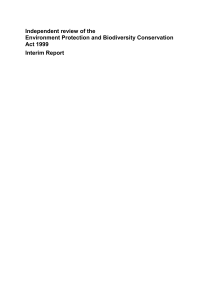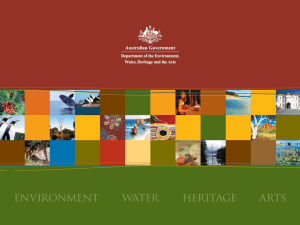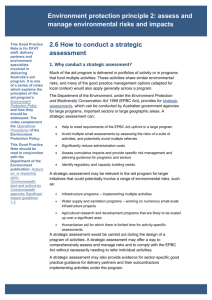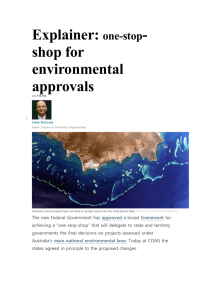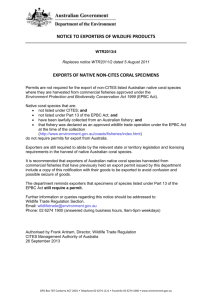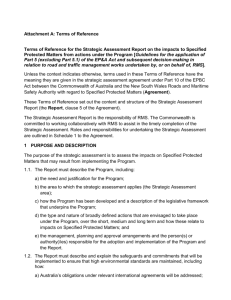Definition of *Environment* under section 528 of the EPBC Act
advertisement
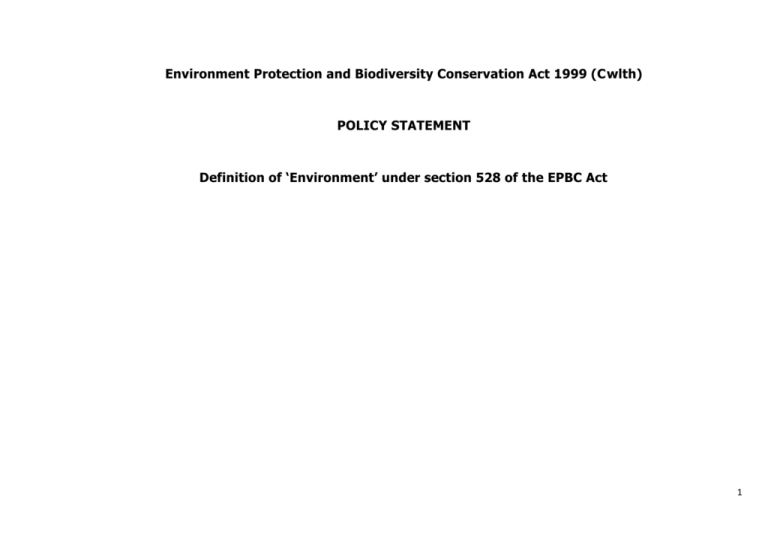
Environment Protection and Biodiversity Conservation Act 1999 (Cwlth) POLICY STATEMENT Definition of ‘Environment’ under section 528 of the EPBC Act 1 Contents Overview .................................................... 1 Actions that impact on the Environment1 Definition of ‘Environment’ under the EPBC Act ............................................................... 2 Parts of the definitionError! Bookmark not defined. (a) ‘Ecosystems and their constituent parts, including people and communities’ ................................................................ 2 (b) ‘Natural and physical resources’ .. 2 (c) ‘Qualities and characteristics of locations, places and areas’ ................ 3 (d) ‘Heritage values of places’ ............ 3 (e) ‘Social economic and cultural’ aspects of a thing mentioned in paragraphs (a), (b), (c) or (d) ........................................ 3 Illustrating the definition ......................... 4 Example 1: Construction of a Railway4 Example 2: Mining for coal on Commonwealth land ............................ 4 OVERVIEW This Policy Statement provides guidance on the definition of the term Environment in the Environment Protection and Biodiversity Conservation Act 1999 (EPBC Act). The EPBC Act prohibits certain actions that, without approval, are likely to or will have a significant impact on the environment. Understanding what is included in the definition of ‘Environment’ in the EBPC Act is important in understanding whether the EPBC Act applies to certain actions. ACTIONS THAT IMPACT ON THE ENVIRONMENT Chapter 2 of the EPBC Act regulates the protection of the environment. It does this by providing a basis for the Minister responsible for administering the EPBC Act or their delegate (Minister) to decide whether an action that has, will have or is likely to have, a significant impact on certain aspects of the environment is acceptable and should be allowed to proceed. Under this part of the EPBC Act, a person is prohibited from taking such an action without the Minister having given approval or deciding that approval is not needed. In order to understand whether an action is likely to have a significant impact on the ‘Environment’, it is necessary to understand the definition of Environment in the EPBC Act. The definition of ‘Environment’ is particularly relevant to approvals under Chapter 4 of the EPBC Act and the controlling provisions under Part 3 of the EPBC Act (refer to section 34 for the specific matter protected by a provision of Part 3) and include: a nuclear action (sections 21, 22 and 22A); an action in a Commonwealth marine area (sections 23 and 24A); an action in the Great Barrier Reef Marine Park (sections 24B and 24C); an action on Commonwealth land (sections 26 and27A); an action on Commonwealth Heritage places overseas (section 27B and 27C); or any action undertaken by the Commonwealth (section 28). These controlling provisions are specifically concerned with the impact of the action on the Environment as defined under the EPBC Act. Under section 67A of the EPBC Act, a person must not take a controlled action unless approval has been granted under Part 9 of the Act. Although section 160 is not a controlling provision under Part 3 of the EPBC Act it does regulate: entry into a foreign aid contract by the Commonwealth which is likely to have a significant impact anywhere in the world on the environment refer to subsection 160(1); the adoption of a plan for aviation airspace management that is likely to have a significant impact on the environment refer to paragraph 160(2)(a); and a major development plan under the Airports Act 1996. DEFINITION OF ‘ENVIRONMENT’ UNDER THE EPBC ACT Section 528 of the EPBC Act defines Environment to include: (d) Heritage values of places; and PARTS OF THE DEFINITION (e) the social, economic and cultural aspects of a thing mentioned in paragraph (a), (b), or (c). (a) ‘Ecosystems and their constituent parts, including people and communities’ Each part of the definition will be considered when determining the likely impacts of a proposed action. Different parts may overlap and the likely impacts of an action may fall into one or more parts of the definition. Ecosystem is defined separately in section 528 of the EPBC Act as being a ‘dynamic complex of plant, animal and micro-organism communities and their non-living environment interacting as a functional unit.’ The EPBC Act does not define all of the terms included in the definition. According to the principles of statutory interpretation, where terms are not defined, their ordinary meaning should be used. Ordinary meaning is generally derived from the dictionary, normally the Macquarie Dictionary. The definition of ‘Environment’ encompasses both ecosystems as a whole and parts of an ecosystem. Those parts of an ecosystem can include people and communities. As such, the relationship between organisms and their environment may also fit into the definition of Environment. Factors such as dependence, interdependence or a symbiotic relationship can point to an ecosystem, which would be included under this part of the definition of ‘Environment’. The definition of ‘Environment’ is not limited to the natural environment. In particular, paragraphs (c) and (d) include the qualities and characteristics of locations, places and areas, and the heritage values of places in the definition. (a) ecosystems and their constituent parts, including people and communities; and (b) natural and physical resources; and (c) the qualities and characteristics of locations, places and areas; and 2 (b) ‘Natural and physical resources’ The term ‘natural and physical resources’ is not defined in the EPBC Act and should be understood according to its ordinary meaning in light of the objects set out in section 3 of the EPBC Act. The Macquarie dictionary1 defines: Natural as something “existing in or formed by nature; not artificial”; and Physical means something “of or pertaining to material nature; material” in other words it is tangible. The definition of ‘resource’ has many meanings and should be construed in the context of the EPBC Act. Whether something constitutes a resource is largely a discretionary matter for decision-makers to ascertain, based on the circumstances at hand. (c) ‘Qualities and characteristics of locations, places and areas’ Section 528 defines ‘place’ to include: (a) a location, area or region or a number of locations, areas or regions; and (b) a building or other structure, or group of buildings or other structures (which may include equipment, furniture, fittings and articles associated or connected with the building or structure, or a group of buildings or structures); and 1 The Macquarie Encyclopaedic Dictionary 1995 (c) in relation to the protection, maintenance, preservation or improvement of a place – the immediate surroundings of a thing in paragraph (a) or (b). The terms ‘qualities,’ ‘characteristic,’ ‘location’ and ‘area’ are not defined and therefore have their ordinary meaning. (d) ‘Heritage values of places’ Section 528 defines Heritage value: [the] heritage value of a place includes the place’s natural and cultural environment having aesthetic, historic, scientific or social significance, or other significance, for current and future generations of Australians. The heritage values of a place are different to listed values for a World Heritage property and/or a National Heritage property. Heritage values do not have to be listed to be considered as part of the ‘Environment’, but listed values may be. Heritage values of a place are concerned with the surrounding natural and cultural environment of a particular (non-listed) place. Heritage values may include intangible qualities such as wilderness values, visual values and cultural values. The heritage values of a place are 3 matters of fact to be determined from the circumstances of the matter at hand. (e) ‘Social economic and cultural’ aspects of a thing mentioned in paragraphs (a), (b), (c) or (d) Paragraph (e) includes the social, economic and cultural aspects of the things set out in paragraphs (a) to (d) in the definition of the ‘Environment’. The ‘Environment’ therefore includes the social, economic and cultural aspects of: (a) ecosystems and their constituent parts, including people and communities; and (b) natural and physical resources; and (c) the qualities and characteristics of locations, places and areas; and (d) heritage values of places. The words ‘social’, ‘economic’ and ‘cultural’ are not defined in the EPBC Act. The social, economic and cultural ‘aspects’ of the environment are different to the economic and social ‘matters’ which must be considered under paragraph 136(1)(b) when the decision-maker decides whether or not to approve the taking of an action. Paragraph 136 (1)(b) relates to economic and social matters associated with the taking of the action overall, whereas section 528(e) provides that social, economic and cultural aspects of, particular ecosystems and natural resources constitute the environment. A distinction is also drawn between a ‘value’ and an ‘aspect’ as referred to in paragraphs (d) and (e) of the definition of the environment. Neither ‘aspect’ nor ‘value’ is defined in the EPBC Act. However, as set out above, ‘heritage value’ is defined in the EPBC Act. A heritage value of a place has aesthetic, historic, scientific or social significance for current and future generations of Australians. Therefore the test for a ‘value’ would be one of significance. In contrast ‘social, economic or cultural’ aspects of a place include a much wider set of circumstances but with less significance attached to them. ILLUSTRATING THE DEFINITION Example 1: Construction of a Railway A proponent proposes to construct a railway through Commonwealth land near a heritage listed place also located on Commonwealth land. A threatened species of bird is known to nest in the area. The railway will alter the landscape, create noise and dust and potentially affect the threatened species of bird. What parts of the Environment is this action likely to impact on? Ecosystems and their constituent parts, including people and communities – ecosystems in the area will be disturbed if the mining proceeds. Flora and fauna will be destroyed or displaced and mining could affect the water table which in turn may affect the local water supplies. The dust and noise of the mining activity will impact on the local fauna and neighbouring community. Community use of the bushland (for example, for recreation purposes) may be prevented. Natural and physical resources – the mining activity will alter the landscape and remove physical resources. The bushland will be removed as part of the mining process and the water table will be affected by the activities. Qualities and characteristics of locations, places and areas – the character of the land will be altered. That is, it will change from being bushland to being a mining area. It will greatly affect the quality of the land as well. The social, economic and cultural aspects of the ecosystem will be affected. The What parts of the ‘Environment’ is this action likely to impact on? Ecosystems and their constituent parts – the ecosystem of the threatened species (and other species included in that ecosystem) is likely to be affected by the noise, dust and alteration of the landscape; and Heritage values of places – the action is likely to impact on the aesthetic and visual values of the heritage place. Example 2: Mining for coal on Commonwealth land A proponent is proposing to mine for coal in an area that is partially on Commonwealth land. The Commonwealth land had been used for defence purposes in the past but for the last few years no defence activity has taken place on the land. The land is mainly bushland and has a small stream running through it. The land is near a suburban residential area which includes schools and shops. 4 mining activities will create dust, noise and alter the landscape. This will impact on local people and their community. The social, economic and cultural aspects of the community will be affected as the mining activities could bring an influx of mining workers into the area. This will mean that infrastructure and support services need to be provided for the increased influx of people and their 5 activities which in turn will affect the local community and may alter the community’s character.
